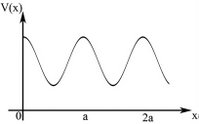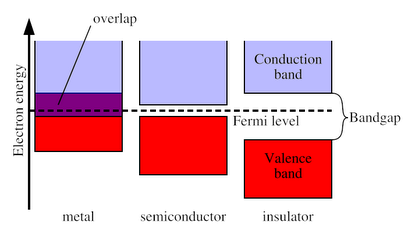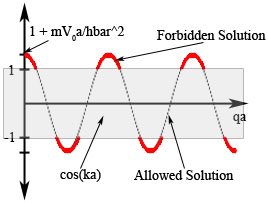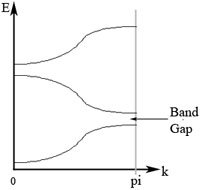Motion in a Periodic Potential
We will now consider the motion of electrons in periodic potentials. An example of such a potential is given in Figure 1.
Figure 1: An example of a periodic potential.
A periodic potential is, by definition, translationally symmetric over a certain period (in Figure 1 it is over a period of Failed to parse (SVG (MathML can be enabled via browser plugin): Invalid response ("Math extension cannot connect to Restbase.") from server "https://wikimedia.org/api/rest_v1/":): {\displaystyle a\!} ); i.e.,
- Failed to parse (SVG (MathML can be enabled via browser plugin): Invalid response ("Math extension cannot connect to Restbase.") from server "https://wikimedia.org/api/rest_v1/":): {\displaystyle V(x)=V(x + a).\!}
In this case, Failed to parse (SVG (MathML can be enabled via browser plugin): Invalid response ("Math extension cannot connect to Restbase.") from server "https://wikimedia.org/api/rest_v1/":): {\displaystyle a\!} is the period.
Bloch's Theorem
The Hamiltonian of a system with a periodic potential of period Failed to parse (SVG (MathML can be enabled via browser plugin): Invalid response ("Math extension cannot connect to Restbase.") from server "https://wikimedia.org/api/rest_v1/":): {\displaystyle a\!} commutes with translations by Failed to parse (SVG (MathML can be enabled via browser plugin): Invalid response ("Math extension cannot connect to Restbase.") from server "https://wikimedia.org/api/rest_v1/":): {\displaystyle a\!:}
- Failed to parse (SVG (MathML can be enabled via browser plugin): Invalid response ("Math extension cannot connect to Restbase.") from server "https://wikimedia.org/api/rest_v1/":): {\displaystyle \hat{T}_a\psi(x)=\psi(x+a)\!}
It is therefore possible to simultaneously diagonalize both the Hamiltonian and the translation operator. We will now show that the eigenfunctions of the Schrödinger equation for this system,
- Failed to parse (SVG (MathML can be enabled via browser plugin): Invalid response ("Math extension cannot connect to Restbase.") from server "https://wikimedia.org/api/rest_v1/":): {\displaystyle \left [-\frac{\hbar^2}{2m}\frac{d^2}{dx^2}+V(x)\right ]\psi(x)=E\psi(x),}
have the form,
- Failed to parse (SVG (MathML can be enabled via browser plugin): Invalid response ("Math extension cannot connect to Restbase.") from server "https://wikimedia.org/api/rest_v1/":): {\displaystyle \psi(x)=e^{ikx}u_k(x)\!}
where
- Failed to parse (SVG (MathML can be enabled via browser plugin): Invalid response ("Math extension cannot connect to Restbase.") from server "https://wikimedia.org/api/rest_v1/":): {\displaystyle u_k(x+a)=u_k(x)\!}
has the same period as the potential; this result is known as Bloch's theorem, and the eigenfunctions are called Bloch waves. To show this, we will prove that eigenfunctions of the translation operator, and thus of the Hamiltonian, have the above form. Applying the translation operator to the proposed wave function, we find that
- Failed to parse (SVG (MathML can be enabled via browser plugin): Invalid response ("Math extension cannot connect to Restbase.") from server "https://wikimedia.org/api/rest_v1/":): {\displaystyle \begin{align} \psi(x+a)&=\hat{T}_a\psi(x) \\ &=\hat{T}_a\left [e^{ikx}u_k(x)\right ] \\ &=\left [e^{ik(x+a)}u_k(x+a)\right ] \\ &=e^{ika}\left [e^{ikx}u_k(x)\right ] \\ &=e^{ika}\psi(x) \end{align}}
We see that the proposed wave function is indeed an eigenfunction of the translation operator, with eigenvalue Failed to parse (SVG (MathML can be enabled via browser plugin): Invalid response ("Math extension cannot connect to Restbase.") from server "https://wikimedia.org/api/rest_v1/":): {\displaystyle e^{ika}.\!} The quantity, Failed to parse (SVG (MathML can be enabled via browser plugin): Invalid response ("Math extension cannot connect to Restbase.") from server "https://wikimedia.org/api/rest_v1/":): {\displaystyle \hbar k,\!} is sometimes referred to as the crystal momentum, since it is a momentum-like quantity that characterizes the eigenstates of a system with discrete, rather than continuous, translational symmetry.
Also note that, if Failed to parse (SVG (MathML can be enabled via browser plugin): Invalid response ("Math extension cannot connect to Restbase.") from server "https://wikimedia.org/api/rest_v1/":): {\displaystyle k\!} is complex, then Failed to parse (SVG (MathML can be enabled via browser plugin): Invalid response ("Math extension cannot connect to Restbase.") from server "https://wikimedia.org/api/rest_v1/":): {\displaystyle \psi(x)\!} will diverge for Failed to parse (SVG (MathML can be enabled via browser plugin): Invalid response ("Math extension cannot connect to Restbase.") from server "https://wikimedia.org/api/rest_v1/":): {\displaystyle x\rightarrow\pm\infty,} with the choice of sign depending on the sign of the imaginary part of Failed to parse (SVG (MathML can be enabled via browser plugin): Invalid response ("Math extension cannot connect to Restbase.") from server "https://wikimedia.org/api/rest_v1/":): {\displaystyle k.\!} Therefore, Failed to parse (SVG (MathML can be enabled via browser plugin): Invalid response ("Math extension cannot connect to Restbase.") from server "https://wikimedia.org/api/rest_v1/":): {\displaystyle k \!} has to be real if Failed to parse (SVG (MathML can be enabled via browser plugin): Invalid response ("Math extension cannot connect to Restbase.") from server "https://wikimedia.org/api/rest_v1/":): {\displaystyle \psi(x)\!} is to be a normalizable wave function.
Applying Bloch's theorem to the Schrödinger equation for a given periodic potential will reveal interesting and important results, such as a "band" structure to the energy spectrum as a function of Failed to parse (SVG (MathML can be enabled via browser plugin): Invalid response ("Math extension cannot connect to Restbase.") from server "https://wikimedia.org/api/rest_v1/":): {\displaystyle k\!.} For materials with weak electron-electron interactions, one can then deduce, given the Fermi energy of the system, whether such a system is metallic (overlapping bands), semiconducting (small gap between bands), or insulating (large gap between bands) (see Figure 2).
Figure 2. Energy band illustration showing the condition for metal, semiconductor, and insulator.
Dirac Comb Potential
As a simple example, let us consider a Dirac comb potential and the resulting Schrödinger equation,
- Failed to parse (SVG (MathML can be enabled via browser plugin): Invalid response ("Math extension cannot connect to Restbase.") from server "https://wikimedia.org/api/rest_v1/":): {\displaystyle V(x)=V_0\sum_{n=-\infty}^{\infty}\delta(x-na)}
and
- Failed to parse (SVG (MathML can be enabled via browser plugin): Invalid response ("Math extension cannot connect to Restbase.") from server "https://wikimedia.org/api/rest_v1/":): {\displaystyle \left(-\frac{\hbar^2}{2m}\frac{d^2}{dx^2}+V_0\sum_{n=-\infty}^{\infty}\delta(x-na)\right)\psi(x)=E\psi(x).}
Let us focus on the region,Failed to parse (SVG (MathML can be enabled via browser plugin): Invalid response ("Math extension cannot connect to Restbase.") from server "https://wikimedia.org/api/rest_v1/":): {\displaystyle 0 < x < a,\!} since the wave function for all Failed to parse (SVG (MathML can be enabled via browser plugin): Invalid response ("Math extension cannot connect to Restbase.") from server "https://wikimedia.org/api/rest_v1/":): {\displaystyle x\!} may be obtained using Bloch's theorem. Within this region, the equation simply reduces to that of a free particle, and thus the solution is
- Failed to parse (SVG (MathML can be enabled via browser plugin): Invalid response ("Math extension cannot connect to Restbase.") from server "https://wikimedia.org/api/rest_v1/":): {\displaystyle \begin{align} \psi_k(x) &= Ae^{iqx}+Be^{-iqx} \\ &= e^{ikx}\left(Ae^{i(q-k)x}+Be^{-i(q+k)x}\right) \\ &= e^{ikx}u_k(x) \end{align} }
with energy Failed to parse (SVG (MathML can be enabled via browser plugin): Invalid response ("Math extension cannot connect to Restbase.") from server "https://wikimedia.org/api/rest_v1/":): {\displaystyle E=\frac{\hbar^2q^2}{2m}.}
Continuity of the wave function and the periodicity of Failed to parse (SVG (MathML can be enabled via browser plugin): Invalid response ("Math extension cannot connect to Restbase.") from server "https://wikimedia.org/api/rest_v1/":): {\displaystyle u_k\!} requires that
- Failed to parse (SVG (MathML can be enabled via browser plugin): Invalid response ("Math extension cannot connect to Restbase.") from server "https://wikimedia.org/api/rest_v1/":): {\displaystyle \psi_k(a^{-})=\psi_k(a^{+})=e^{ika}\psi_k(0^{+}).\!}
Applying this condition to our wave function, we obtain
- Failed to parse (SVG (MathML can be enabled via browser plugin): Invalid response ("Math extension cannot connect to Restbase.") from server "https://wikimedia.org/api/rest_v1/":): {\displaystyle Ae^{iqa}+Be^{-iqa}=e^{ika}(A+B).\!} (1)
Recall that the derivative of the wave function at a delta function potential is discontinuous, with the discontinuity given by
- Failed to parse (SVG (MathML can be enabled via browser plugin): Invalid response ("Math extension cannot connect to Restbase.") from server "https://wikimedia.org/api/rest_v1/":): {\displaystyle \psi'_k(a^{+})-\psi'_k(a^{-})=\frac{2mV_0}{\hbar^2}\psi_k(a).}
One may easily verify that the derivative of the wave function satisfies
- Failed to parse (SVG (MathML can be enabled via browser plugin): Invalid response ("Math extension cannot connect to Restbase.") from server "https://wikimedia.org/api/rest_v1/":): {\displaystyle \psi'_k(x+a)=e^{ika}\psi'_k(x),\!}
so that
- Failed to parse (SVG (MathML can be enabled via browser plugin): Invalid response ("Math extension cannot connect to Restbase.") from server "https://wikimedia.org/api/rest_v1/":): {\displaystyle \psi'_k(a^{-})=\psi'_k(a^{+})=e^{ika}\psi'_k(0^{+}).\!}
We may now find the derivative of the wave function just to the left and just to the right of the delta function:
- Failed to parse (SVG (MathML can be enabled via browser plugin): Invalid response ("Math extension cannot connect to Restbase.") from server "https://wikimedia.org/api/rest_v1/":): {\displaystyle \psi'_k(a^{-})=iq(Ae^{iqa}-Be^{-iqa})\!}
- Failed to parse (SVG (MathML can be enabled via browser plugin): Invalid response ("Math extension cannot connect to Restbase.") from server "https://wikimedia.org/api/rest_v1/":): {\displaystyle \psi'_k(a^{+})=iqe^{ika}(A-B)\!}
We thus obtain
- Failed to parse (SVG (MathML can be enabled via browser plugin): Invalid response ("Math extension cannot connect to Restbase.") from server "https://wikimedia.org/api/rest_v1/":): {\displaystyle iq(Ae^{ika}-Be^{ika}-Ae^{iqa}+Be^{-iqa})=\frac{2mV_0}{\hbar^2}e^{ika}(A+B).} (2)
By requiring that Equations (1) and (2) have non-trivial solutions, we obtain the following relation between Failed to parse (SVG (MathML can be enabled via browser plugin): Invalid response ("Math extension cannot connect to Restbase.") from server "https://wikimedia.org/api/rest_v1/":): {\displaystyle q\!} and Failed to parse (SVG (MathML can be enabled via browser plugin): Invalid response ("Math extension cannot connect to Restbase.") from server "https://wikimedia.org/api/rest_v1/":): {\displaystyle k:\!}
- Failed to parse (SVG (MathML can be enabled via browser plugin): Invalid response ("Math extension cannot connect to Restbase.") from server "https://wikimedia.org/api/rest_v1/":): {\displaystyle \cos(ka)=\cos(qa)+\frac{mV_0a}{\hbar^2}\frac{\sin(qa)}{qa}} (3)
To obtain the energy bands, we now simply need to solve for Failed to parse (SVG (MathML can be enabled via browser plugin): Invalid response ("Math extension cannot connect to Restbase.") from server "https://wikimedia.org/api/rest_v1/":): {\displaystyle q\!} for a given value of Failed to parse (SVG (MathML can be enabled via browser plugin): Invalid response ("Math extension cannot connect to Restbase.") from server "https://wikimedia.org/api/rest_v1/":): {\displaystyle k\!} and substitute the result into the energy given above. Since there can be multiple values of Failed to parse (SVG (MathML can be enabled via browser plugin): Invalid response ("Math extension cannot connect to Restbase.") from server "https://wikimedia.org/api/rest_v1/":): {\displaystyle q\!} that satisfy the above equation, we see that there are multiple "energy bands" in our system. Note that the maximum value of the left-hand side of (3) is less than that of the right-hand side. This implies that there are some values of Failed to parse (SVG (MathML can be enabled via browser plugin): Invalid response ("Math extension cannot connect to Restbase.") from server "https://wikimedia.org/api/rest_v1/":): {\displaystyle q\!} that cannot be obtained for any Failed to parse (SVG (MathML can be enabled via browser plugin): Invalid response ("Math extension cannot connect to Restbase.") from server "https://wikimedia.org/api/rest_v1/":): {\displaystyle k.\!} The energies corresponding to these values of Failed to parse (SVG (MathML can be enabled via browser plugin): Invalid response ("Math extension cannot connect to Restbase.") from server "https://wikimedia.org/api/rest_v1/":): {\displaystyle q\!} are "forbidden bands" (see Fig. 3). We sketch the energy bands of the system as a function of Failed to parse (SVG (MathML can be enabled via browser plugin): Invalid response ("Math extension cannot connect to Restbase.") from server "https://wikimedia.org/api/rest_v1/":): {\displaystyle k\!} in Fig. 4.
Figure 3. Sketch of the right-hand side of Equation (3). The curve is the right-hand side, while the box represents the range of the left-hand side. The solid red portions of the curve represent the forbidden bands, while the dashed black portions represent the allowed bands.
Figure 4. Sketch of the energy bands for the Dirac comb potential as a function of Failed to parse (SVG (MathML can be enabled via browser plugin): Invalid response ("Math extension cannot connect to Restbase.") from server "https://wikimedia.org/api/rest_v1/":): {\displaystyle k.\!} The band gap, corresponding to the forbidden energy bands, is labeled.
We see that, in conjunction with Pauli exclusion principle, the single-particle band spectrum of a periodic potential, such as the one we discussed here, gives us a simple description of band insulators and band metals.
Problem
Let us now consider a more general case, namely a square wave potential, given by
- Failed to parse (SVG (MathML can be enabled via browser plugin): Invalid response ("Math extension cannot connect to Restbase.") from server "https://wikimedia.org/api/rest_v1/":): {\displaystyle V(x)=\begin{cases} 0, & na < x < na+c \\ V_0, & na+c < x < (n+1)a, \end{cases} }
where Failed to parse (SVG (MathML can be enabled via browser plugin): Invalid response ("Math extension cannot connect to Restbase.") from server "https://wikimedia.org/api/rest_v1/":): {\displaystyle n\!} runs over all integers. Determine the energy spectrum for this potential and show that it reduces to the result for the Dirac comb when Failed to parse (SVG (MathML can be enabled via browser plugin): Invalid response ("Math extension cannot connect to Restbase.") from server "https://wikimedia.org/api/rest_v1/":): {\displaystyle c\rightarrow a\!} and in such a way that the product, remains finite.





